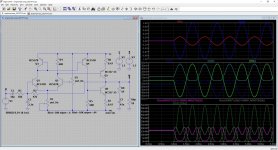It works down to +/-2.0V.
Distortion is low and current consumption is only like 3-4mA depending on the status of the batteries.
Has been tested in simulation with 32ohm and 300ohm load.
I challenge everybody to try to design a real lowpower headphone amp for +/-2.0V.
Post your schematic here.

Distortion is low and current consumption is only like 3-4mA depending on the status of the batteries.
Has been tested in simulation with 32ohm and 300ohm load.
I challenge everybody to try to design a real lowpower headphone amp for +/-2.0V.
Post your schematic here.
My old abandoned thread. The tricky part is to bias it in class B.
Output swing: +-1V
Output current: >500mA
I was amazed my 5 inches shelf speaker can play pretty loud with just 2 AA battery.
This kind of out put stage seems to work pretty well with full swing of power supplier. I am thinking about to up scale it to larger power.
PS: It is able to work in Class B, with extremely low distortion.
Output current: >500mA
I was amazed my 5 inches shelf speaker can play pretty loud with just 2 AA battery.
This kind of out put stage seems to work pretty well with full swing of power supplier. I am thinking about to up scale it to larger power.
PS: It is able to work in Class B, with extremely low distortion.
@lineup , thank you. However, I don't really the circuit. I built 4, and hooked them in btl for 2 channels just for the prove of concept.
Here is another design, not from me. It could work in very low voltage too.
The long tail from LTP can be swapped out with a trimmable current source for bias stability.
Here is another design, not from me. It could work in very low voltage too.
The long tail from LTP can be swapped out with a trimmable current source for bias stability.
do we need the bd transistors at such low supply voltages?It works down to +/-2.0V.
Distortion is low and current consumption is only like 3-4mA depending on the status of the batteries.
Has been tested in simulation with 32ohm and 300ohm load.
I challenge everybody to try to design a real lowpower headphone amp for +/-2.0V.
Post your schematic here.
View attachment 1431466
Many CMOS opamps can do that I suspect. For instance the AD8656 can drive +/-75mA and run from +/-1.35V supplies upto +/-2.5V supplies. You could do a bridge-tied version if your headphones are 4 wire rather than 3 wire for more volume, though that might be stretching the output stage too far. Current consumption 3.7mA per channel.I challenge everybody to try to design a real lowpower headphone amp for +/-2.0V.
I have described a number of low-voltage, low-power amplifiers.
Here is a example:
This one operates from an even lower voltage, and is frugal enough to dispense with a power switch:
https://www.diyaudio.com/community/...ovative-in-line-amplifier.385011/post-6991150
Another one:
Here is a example:
Hi,
Here is a small, low-voltage (3V or less) amplifier.
I wanted a signal-tracer amplifier, very small, and battery operated to be used in completely floating situations: like typically to measure the noise across a component.
This amplifier fits the bill. It is rather crude, but has some interesting features: it uses same-sex output transistors, operates efficiently at ridiculously low voltage levels, and yet offers a decent quality: here, it is shown at max output power, and the THD is well under 2%, with a nice harmonic profile.
At lower power, the distortion is even lower.
Also...
Here is a small, low-voltage (3V or less) amplifier.
I wanted a signal-tracer amplifier, very small, and battery operated to be used in completely floating situations: like typically to measure the noise across a component.
This amplifier fits the bill. It is rather crude, but has some interesting features: it uses same-sex output transistors, operates efficiently at ridiculously low voltage levels, and yet offers a decent quality: here, it is shown at max output power, and the THD is well under 2%, with a nice harmonic profile.
At lower power, the distortion is even lower.
Also...
https://www.diyaudio.com/community/...ovative-in-line-amplifier.385011/post-6991150
Another one:
Here is another project inspired by Danny: it is based on the same principles as the BoosterPhone, low supply requirements, rail-to-rail output on a low impedance, in this case 600 ohm and decent audio quality without too much complications.
It is designed to match older sources, delivering 150~200mV to modern equipments requiring 700mV or more. It thus mimics a passive step-up transformer, but without the impedance penalty: a 1:4 step-up transformer increases the impedance by a factor of 16, which can be problematic. Instead, the output impedance is much lower than the input...
It is designed to match older sources, delivering 150~200mV to modern equipments requiring 700mV or more. It thus mimics a passive step-up transformer, but without the impedance penalty: a 1:4 step-up transformer increases the impedance by a factor of 16, which can be problematic. Instead, the output impedance is much lower than the input...
Here's a discrete 5V single supply CMOS opamp (CD4049UB based) with rail to rail output suitable for headphone application. It retains the inverting output stage like the one by jxd in post #2, and the reported slew rate is impressive.It's 2025 and we use 5V USB power banks now ...
https://www.edn.com/a-true-op-amp-made-from-inverters/
Last edited:
The CD4049 doesn't do much at 5V, but one could use the 74HCU04 (25mA@5V) instead. It may also be necessary to keep an eye on the supply current. Further, with the VCC/GND connections common anyway, all gates on a chip could be paralleled to boost the output.
- Home
- Amplifiers
- Headphone Systems
- Discrete 4x1.5V Battery Headphone Amp, Lowpower


